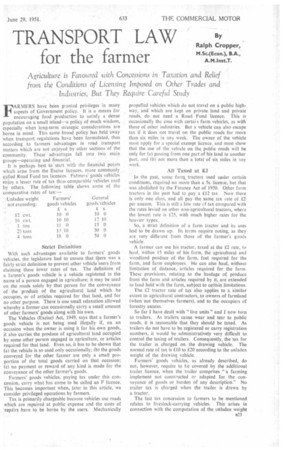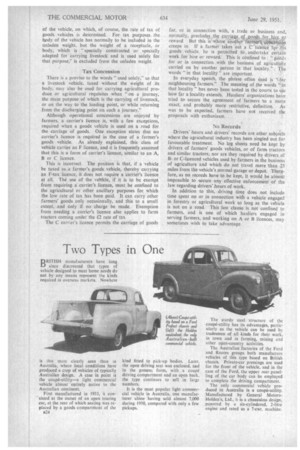TRANSPORT LAW
Page 97

Page 98

If you've noticed an error in this article please click here to report it so we can fix it.
for the farmer
Agriculture is Favoured with Concessions in Taxation and Relief from the Conditions of Licensing Imposed on Other Trades and Industries, But They Require Careful Study By Ralph Cropper,
M.Sc.(Econ.), B.A., A. M .1 nst.T.
FARMERS have been granted privileges in many aspects of Government policy. It is a means for encouraging food production to satisfy a dense population on a small island—a policy of much wisdom, especially when long-term strategic considerations are borne in mind. This same broad policy has held sway when transport regulations have been formulated, thus according to farmers advantages in road transport matters which are not enjoyed by othersections of the community. These . advantages fall into two main
groups—operating and financial, :
It is perhaps best to.'start With the financial points which arise from the Excise licences, more commonly called Road Fund tax licences. Fatmers' goods vehicles enjoy a lesser rate of tax than comparable vehicles used by others. The following table shows some of the comparative rates of tax:—
Strict Definition With such advantages available to farmers' goods vehicles, the legislature had to ensure that there was a fairly strict definition to prevent other vehicle users from claiming these lower rates of tax. The definition of a farmer's goods vehicle is a vehicle registered in the name of a person engaged in agriculture; it may be used' on the roads solely by that person for the conveyance of the produce of the agricultural land which he occupies, or of articles required for that land, and for no other purpose. There is one small relaxation allowed whereby a farmer can occasionally carry a small amount of other farmers' goods along with his own.
The Vehicles (Excise) Act, 1949, says that a farmer's'
goods vehicle is not being used illegally if, on an occasion when the owner is using it for his own goods, it also carries the produce of agricultural land occupied by some other person engaged in agriculture, or articles required for that land. Even so, it has to be shown that (a) the vehicle is so used only occasionally; (b) the goods conveyed for the other farmer are only a small proportion of the total goods carried on that occasion; (c) no payment or reward of any kind is made for the conveyance of the other farmer's goods.
Farmers' goods vehicles, paying tax under this concession, carry what has come to be called an F licence. This becomes important when, later in this article, we consider privileged operations by farmers.
Tax is primarily chargeable because vehicles use roads which are repaired at public expense and the costs of repairs have to be borne by the users. Mechanically propelled vehicles which do not travel on a public highway, and which arc kept on private land and private roads, do not need a Road Fund licence. This is occasionally the case with certail farm vehicles, as with those of other industries. But a vehicle can also escape tax if it does not travel on the public roads for more than six miles in any week. The owner of the vehicle must apply for a special exempt licence, and must show that the use of the vehicle on the public roads will be only for (a) passing from one part of his land to another part, and (b) not mort than a total of six miles in any week.
All Taxed at £2 In the past, sonic farria, tractors used under certain cOnditions, required no more than a 5s. licence, but that was abolished by the Finance Act of 1950.. Other farm tractors in the past had to pay a il2 tax. Now there is only one class, and all pay the same tax tate of 12 per annum. This is still a low rate of tax compared with the rates levied on other non-agricultural tractors, where the lowest rate is £25, with much higher rates for the heavier types.
So, a strict definition of a farm tractor and its uses had to be drawn up. Its terms require noting, as they are very different from those of the farmer's goods vehicle.
A farmer can use his tractor, taxed at the 12 rate, to haul. within 15 miles of his farm, the agricultural and woodland produce of the farm, fuel required for the farm, and farm employees. He can also haul, without limitation of distance, articles required for the farm. These provisions, relating to the haulage of produce from the farm and articles required by it, are extended to land held with the farm, subject to certain limitations.
The £2 tractor rate of tax also applies to a similar extent to agricultural contractors, to owners of farmland (when mot themselves farmers), and to the occupiers of forestry estates.
So far I have dealt with "live units" and I now turn to trailers. As trailers cause wear and tear to public roads, it is reasonable that they should be taxed. As trailers do not have to be registered or carry registration numbers, it would be administratively very difficult to control the taxing of trailers. Consequently, the tax for the trailer is charged on the drawing vehicle. The normal rate of tax is £10 to £20 according to the unladen weight of the drawing vehicle..
Farmers' goods vehicles, as already described, do not, however, require to be covered by the additional trailer licence, when the trailer comprises "a farming implement not constructed or adapted for the conveyance of goods or burden of any description." No trailer tax is charged when the trailer is drawn by a tractor.
The last tax concession to farmers to be mentioned relates to livestock-carrying vehicles. This arises in connection with the computation of the unladen weight n23
of the vehicle, on which, of course, the rate of tax of goods vehicles is determined. For tax purposes the body of the vehicle has normally to he included in the unladen weight, but the weight of a receptacle, or body, which is " specially constructed or specially adapted for carrying livestock and is used solely for that purpose," is excluded from the unladen weight.
Tax Concession There is a proviso to the words " used solely," so that a livestock vehicle, taxed without the weight of its body, may also be used for carrying agricultural produce or agricultural requisites when "on a journey, the main purpose of which is the carrying of livestock, or on the way to the loading point, or while returning from the discharging point on such a journey."
Although operational concessions are enjoyed by farmers, a carrier's licence is, with a few exceptions, required when a goods vehicle is used on a road for the carriage of goods. One exception states that no carrier's licence is required in the case of a farmer's goods vehicle. As already explained, this class of vehicle carries an F licence, and it is frequently assumed that this is a form of carrier's licence, similar to an A, B or C licence.
This is incorrect. The position is that, if a vehicle be taxed as .a farmer's goods vehicle, thereby carrying an F-tax' licence, it does not require a 'carrier's licence at all. The use of the vehicle, if it is to be exempt from requiring a carrier's licence, must be confined to the agricultural or other ancillary purposes for which the low rate of tax has been paid. It can carry other farmers' goods only occasionally, and this to a small extent, and only if no charge be made. Exemption from needing a carrier's licence also applies to farm tractors coming under the 12 rate of tax The C carrier's licence permits the carriage of goods
for, or in connection with, a trade or business and, normally, precludes ,the carriage94.,gooasfoi.J.its. qr reward But this is'Where•a7nathp'..fiftliter‘w.Zzli creeps in. If a farmer takes 'Clin a 'Ciic'19i.his goods •vehicle, he is permitted to, undertake certain work for hire or reward. This is confined to
for or in connection with the business of agriculttire carried on by another person in that locality." . The words "in that locality" are important.
In everyday speech, the phrase often Used is 't, for neighbouring farmers." The meaning of the words ".in that locality" has never been tested in the courts to see how far a locality extends. Hauliers' organizations have tried to secure the agreement of farmers to a more exact, and probably more restrictive, definition. As was to be expected, farmers have not received the proposals with enthusiasm.
No Records
Drivers' hours and drivers' records are other subjects where the agricultural industry has been singled out for favourable treatment. No log sheets need be kept by drivers of farmers' goods vehicles, or of farm tractors and similar tractors; nor are they required by drivers of 13or C-licenced vehicles used by farmers in the business of agriculture and which do not travel more 'than 25 miles from the vehicle's normal garage or depot. Therefore, as no records have to be kept, it would be almost impossible to secure any effective enforcement of the law regarding drivers' hours of work.
In addition to this, driving time does not include time spent on or in connection with a vehicle engaged in forestry or agricultural work so long as the vehicle is not on a road This last clause is not confined to farmers, and is one of which hauliers engaged in serving farmers, and working on A or 13 licences, may sometimes wish to take advantage.












































































































































